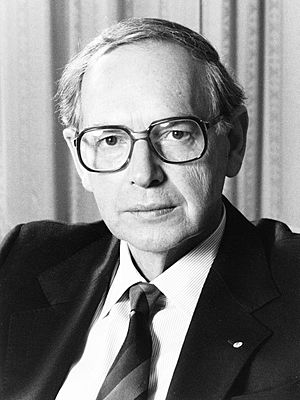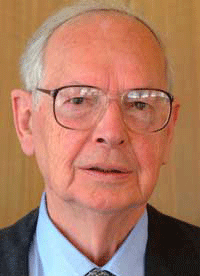Ninian Stephen facts for kids
Quick facts for kids
Ninian Stephen
|
|
|---|---|
 |
|
| 20th Governor-General of Australia | |
| In office 29 July 1982 – 16 February 1989 |
|
| Monarch | Elizabeth II |
| Prime Minister | Malcolm Fraser Bob Hawke |
| Preceded by | Sir Zelman Cowen |
| Succeeded by | Bill Hayden |
| Justice of the High Court of Australia | |
| In office 1 March 1972 – 11 May 1982 |
|
| Nominated by | Billy McMahon |
| Appointed by | Sir Paul Hasluck |
| Preceded by | Sir Victor Windeyer |
| Succeeded by | Sir William Deane |
| Judge of the Supreme Court of Victoria | |
| In office 30 June 1970 – 29 February 1972 |
|
| Nominated by | Sir Henry Bolte |
| Appointed by | Sir Rohan Delacombe |
| Preceded by | Robert Monahan |
| Succeeded by | William Kaye |
| Personal details | |
| Born |
Ninian Martin Stephen
15 June 1923 Nettlebed, Oxfordshire, England |
| Died | 29 October 2017 (aged 94) Melbourne, Victoria, Australia |
| Spouse |
Valery Sinclair
(m. 1949) |
| Children | 5 |
| Profession | Barrister, judge |
| Military service | |
| Allegiance | Australia |
| Branch/service | Second Australian Imperial Force |
| Years of service | 1941–1946 |
| Rank | Lieutenant |
| Unit | Royal Australian Artillery Royal Australian Engineers |
| Battles/wars | Second World War |
Sir Ninian Martin Stephen (born 15 June 1923 – died 29 October 2017) was an important Australian judge. He served as the 20th Governor-General of Australia from 1982 to 1989. Before that, he was a judge on Australia's highest court, the High Court of Australia, from 1972 to 1982.
Ninian Stephen was born in England. His parents were from Scotland. As a child, he lived in many different countries like France, Germany, Scotland, and Switzerland. He moved to Australia when he was 16 years old.
During World War II, Stephen served in the Australian Army. After the war, he became a lawyer. He was known as one of Australia's best lawyers in matters of the country's laws (constitutional law). In 1970, he became a judge in the Supreme Court of Victoria. Then, in 1972, he joined the High Court when he was 48.
In 1982, Ninian Stephen was chosen to be the Governor-General. This is the King or Queen's representative in Australia. He was the only Governor-General to approve two "double dissolutions." This is when both parts of the Australian Parliament are dissolved for an election. After his time as Governor-General, he worked to protect the environment. He also served on international courts. He passed away at 94, becoming Australia's longest-living Governor-General.
Contents
Growing Up: Early Life and Education
Ninian Stephen was born in a place called Nettlebed in England. His parents, Barbara and Frederick Stephen, were Scottish. His father left the family soon after Ninian was born. Ninian was told his father had died, but he found out the truth much later.
Ninian's mother worked as a paid companion for a rich lady named Nina Mylne. Ninian's first name was given in Nina Mylne's honour. When Ninian was very young, he, his mother, and Nina Mylne lived in many different places. They lived in Switzerland, France, and Germany. Nina Mylne even took him to a big political gathering in Germany in 1938.
In 1929, they moved to Edinburgh, Scotland, so Ninian could start school. Nina Mylne paid for his education. He went to schools in Scotland, London, and Switzerland. In 1940, they all moved to Melbourne, Australia, to avoid the war. Ninian went to Scotch College for a short time. Then he started studying law at the University of Melbourne.
Serving in the Second World War
In December 1941, after his first year at university, Ninian Stephen joined the army. He trained part-time in the Melbourne University Regiment. When Japan joined World War II, Stephen began full-time military training.
He was sent to serve in Western Australia with the Royal Australian Artillery. Later, he joined the main Australian Army. In 1943, he moved to the Royal Australian Engineers. He served in New Guinea from April to August 1944. He then became a lieutenant in 1945. He served in New Guinea and New Britain. In August 1945, he was sent to Labuan, Borneo. He arrived after the war had ended. He stayed there until January 1946. He left the army in February 1946.
Becoming a Lawyer: Legal Career
After the war, Ninian Stephen finished his law studies. He became a lawyer in Victoria in 1949. By the 1960s, he was one of Australia's top lawyers. He was very skilled in laws about the country's constitution and business. In 1966, he was made a Queen's Counsel. This is a special title for very experienced lawyers.
Working as a Judge: Judicial Career
On 30 June 1970, Ninian Stephen became a judge of the Supreme Court of Victoria. He held this job until February 1972. Then, he became a judge on the High Court of Australia, which is the highest court in the country. In 1979, he became a member of the Privy Council, a group of advisors to the British monarch.
Even though a conservative government appointed him, Stephen was seen as a fair and balanced judge. He was part of the "moderate centre" of the High Court. This meant he was not too traditional or too radical in his legal views. In 1982, he was part of a group of judges who made an important decision. They decided that the Australian government had broad powers in international matters. This was in a case called Koowarta v Bjelke-Petersen.
Australia's Governor-General
In March 1982, the Prime Minister, Malcolm Fraser, announced that Queen Elizabeth II had approved Ninian Stephen as the next Governor-General of Australia. Everyone, from both sides of politics, thought this was a great choice. He officially started his role on 29 July 1982. He was the first former High Court judge to become Governor-General since 1931.
When Malcolm Fraser's government lost the election in 1983, Bob Hawke became the new Prime Minister. Stephen worked well with the new Labor government. In 1987, his term was extended. This was a sign of respect for him. It also allowed Bill Hayden to take on the role when he was ready. Stephen is the only Governor-General who has approved two "double dissolutions." These happened in 1983 and 1987.
After His Term: Later Work
In 1989, Ninian Stephen became Australia's first Ambassador for the Environment. For three years, he worked hard to ban mining in Antarctica. In 1990, he became the head of the Australian Antarctic Foundation. He also led the Constitutional Centenary Foundation.
In 1991, he took on a difficult job. He was chosen to lead part of the peace talks in Northern Ireland. From 1991 to 1995, he was a judge for the International Court of Justice in a case about East Timor. From 1993 to 1997, he was a judge on international courts that looked into war crimes in Yugoslavia and Rwanda. He also helped solve political problems in Bangladesh in 1994.
Later, Stephen returned to legal work. He became the head of a special court that settled a business dispute between a Canadian company and the United States.
A detailed book about Ninian Stephen, called Fortunate Voyager, was written by Philip Ayres in 2013.
Awards and Honours
| Viceregal styles of Sir Ninian Stephen |
|
|---|---|
| Reference style | His Excellency The Right Honourable |
| Spoken style | Your Excellency |
Ninian Stephen received many important awards and honours.
- In 1972, he was made a Knight Commander of the Order of the British Empire (KBE) for his excellent work in law.
- In 1979, he became a member of the Privy Council.
- As Governor-General, he received several high honours:
- In 1994, Queen Elizabeth II personally made him a Knight of the Order of the Garter (KG). This is a very special honour. He was one of the few Australians to receive this.
- In 1983, he was also given the French Légion d'honneur (Commandeur).
The University of Newcastle's law school named a special lecture series after him in 1993, called the Sir Ninian Stephen Lecture.
Family Life and Passing
In June 1949, Ninian Stephen married Valery Mary Sinclair. They had five daughters together. Ninian and Valery were supporters of the Australian Inland Botanic Gardens.
Ninian Stephen passed away in Melbourne on 29 October 2017, at the age of 94. A state funeral, a special ceremony paid for by the government, was held for him on 8 November at St Paul's Cathedral, Melbourne.
Images for kids
See also
 In Spanish: Ninian Stephen para niños
In Spanish: Ninian Stephen para niños



